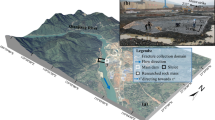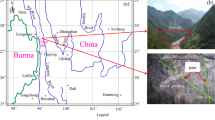Abstract
This study presents a new three-dimensional (3D) network modelling method for fractures collected in a large sampling window, in which the determination of fracture disc diameter is the critical step. To derive the diameter, the disc radius of the fractures of the investigated exposed rock surface is initially obtained based on the collected trace lengths. Then, the disc radius of the fractures in 3D space is deduced. The determination of the density and orientation of fractures is also included in the study. Subsequently, the 3D fracture networks for each fracture set are generated based on the derived diameter, density and orientation. To verify the rationality of the method, the rock masses downstream of the sluice gate of Datengxia hydropower station are selected as study objects, and a plane with identical orientation to the exposed rock surface is intersected by the network, thereby obtaining the fracture traces in the plane. The statistical characteristics of fracture traces in the plane and those of the exposed rock surface are highly similar. Thus, the proposed method is feasible.












Similar content being viewed by others
Abbreviations
- A :
-
The area for fracture collection in the field [m2]
- A′:
-
The intersection area between the three-dimensional fracture network and the virtual exposed rock surface [m2]
- α :
-
The average intersection angle of the fracture disc to the exposed rock surface in an interval of dip angle [°]
- ch:
-
Half-trace length [m]
- χ 2 :
-
Chi square [–]
- D :
-
Standard deviation [–]
- E :
-
Average value [–]
- F :
-
The random numbers of ch2 [m2]
- F′ :
-
The random numbers of truncated ch2 [m2]
- f :
-
The probability that a fracture can be collected on the exposed rock surface [–]
- γ :
-
The scale parameter of gamma distribution [–]
- θ :
-
The intersection angle of the fracture disc to the exposed rock surface [°]
- k :
-
The shape parameter of gamma distribution [–]
- L :
-
The height of three-dimensional space that accommodates the fractures [m]
- λ :
-
The rate parameter of negative exponential distribution [–]
- M S :
-
Magnitude of earthquake [–]
- μ :
-
The identical location parameter of logarithmic normal distribution [–]
- N :
-
The number of fractures collected in the field [–]
- N′ :
-
The number of fracture traces in the virtual exposed rock surface [–]
- N α :
-
The number of fractures collected from the field intersecting the exposed rock surface at an average intersection angle of α [–]
- N ′ α :
-
The number of fractures in three-dimensional fracture network intersecting the exposed rock surface at an average intersection angle of α [–]
- n :
-
The number of fractures in the three-dimensional fracture network (fracture density) [–]
- n ab :
-
The number of fractures with radius between a and b that intersects with the exposed rock surface [–]
- n′ab :
-
The number of fractures with radius between a and b in three-dimensional space [–]
- P 1 :
-
Frequency of fractures of different orientations in the field [%]
- P 2 :
-
Frequency of fractures of different orientations in three-dimensional fracture network [%]
- P 20 :
-
Number of fracture traces per unit area [m−2]
- P 21 :
-
Total length of fracture traces per unit area [m/m2]
- r :
-
Fracture disc radius [m]
- r′ :
-
Fracture disc radius in three-dimensional space [m]
- σ :
-
The identical location parameter of logarithmic normal distribution [–]
- u :
-
The distance between the fracture disc centre and the midpoint of the fracture trace [m]
- U(0,1):
-
Uniform distribution between 0 and 1
- X :
-
The number of intervals divided from the random numbers of r [–]
References
Barton CC, Larsen E (1985) Fractal geometry of two-dimensional fracture networks at Yucca Mountain, Southwestern Nevada. In: Fundamentals of rock joints: proceedings of the international symposium on fundamentals of rock joints, pp 77–84. https://corescholar.libraries.wright.edu/ees/74
Bauer M, Toth TM (2017) Characterization and DFN modelling of the fracture network in a Mesozoic karst reservoir: Gomba Oilfield, Paleogene Basin, Central Hungary. J Pet Geol 40(3):319–334
Billaux D, Chiles JP, Hestir K, Long J (1989) 3-Dimensional statistical modeling of a fractured rock mass—an example from the Fanay-Augeres mine. Int J Rock Mech Min Sci Geomech Abstr 26(3–4):281–299
Bryant FB, Satorra A (2012) Principles and practice of scaled difference Chi-square testing. Struct Equ Model A Multidiscip J 19(3):372–398
Cheng JT, Morris JP, Tran J, Lumsdaine A, Giordano NJ, Nolte DD, Pyrak-Nolte LJ (2004) Single-phase flow in a rock fracture: micro-model experiments and network flow simulation. Int J Rock Mech Min Sci 41:687–693
Fouche O, Diebolt J (2004) Describing the geometry of 3D fracture systems by correcting for linear sampling bias. Math Geol 36(1):33–63
Grenon M, Hadjigeorgiou J (2003) Open stope stability using 3D joint networks. Rock Mech Rock Eng 36(3):183–208
Han XD, Chen JP, Wang Q, Li YY, Zhang W, Yu TW (2016) A 3D fracture network model for the undisturbed rock mass at the Songta Dam site based on small samples. Rock Mech Rock Eng 49(2):611–619
Hudson JA, Harrison JP (1997) Engineering rock mechanics: an introduction to the principles. Pergamon, London
Hudson JA, Priest SD (1979) Fracture and rock mass geometry. Int J Rock Mech Min Sci Geomech Abstr 16:339–362
Kulatilake PHSW, Wu TH (1984) Estimation of mean trace length of discontinuities. Rock Mech Rock Eng 17(4):215–232
Kulatilake PHSW, Wu TH (1986) Relation between discontinuity size and trace length. In: Proceedings of the 27th U.S. rock mechanics symposium
Laghaei M, Baghbanan A, Hashemolhosseini H, Dehghanipoodeh M (2018) Numerical determination of deformability and strength of 3D fractured rock mass. Int J Rock Mech Min Sci 110:246–256
Lambert C, Thoeni K, Giacomini A, Casagrande D, Sloan S (2012) Rockfall hazard analysis from discrete fracture network modelling with finite persistence discontinuities. Rock Mech Rock Eng 45(5):871–884
Ma JJ, Lu D, Liu ZL (2017) Application of 3D laser scanning technology in complex rock foundation design. 3D Res 8(4):34
Mantel N (1963) Chi-square tests with one degree of freedom; extensions of the Mantel–Haenszel procedure. J Am Stat Assoc 58:690–700
Min KB, Jing LR (2003) Numerical determination of the equivalent elastic compliance tensor for fractured rock masses using the distinct element method. Int J Rock Mech Min Sci 40(6):795–816
Morales A, Sanchez-Aparicio LJ, Gonzalez-Aguilera D, Gutierrez MA, Lopez AI, Hernandez-Lopez D, Rodriguez-Gonzalvez P (2017) A new approach to energy calculation of road accidents against fixed small section elements based on close-range photogrammetry. Remote Sens 9(12):1219
Oda M (1982) Fabric tensor for discontinous geological materials. Soils Found 22:96–108
Palleske CK, Hutchinson DJ, Elmo D, Diederichs MS (2013) Impacts of limited data collection windows on accurate rock simulation using discrete fracture networks. In: 47th U.S. rock mechanics/geomechanics symposium. American Rock Mechanics Association
Priest SD (1985) Hemispherical projection methods in rock mechanics. George Allen & Unwin, London
Priest SD (1993) Discontinuity analysis for rock engineering. Chapman & Hall, London
Priest SD, Hudson JA (1981) Estimation of discontinuity spacing and trace length using scanline survey. Int J Rock Mech Min Sci Geomech Abstr 18(3):183–197
Robertson AM (1970) The interpretation of geological factors for use in slope theory. In: Planning open pit mines, pp 55–71
Shanley RJ, Mahtab MA (1975) FRACTAN: a computer code for analysis of clusters defined on the unit hemisphere. Bureau of Mines, IC8671
Shanley RJ, Mahtab MA (1976) Delineation and analysis of clusters in orientation data. J Int Assoc Math Geol 8(1):9–23
Terzaghi RD (1965) Sources of error in joint surveys. Geotechnique 15:287–304
Tonon F, Chen S (2007) Closed-form and numerical solutions for the probability distribution function of fracture diameters. Int J Rock Mech Min Sci 44(3):322–350
Tonon F, Chen S (2010) On the existence, uniqueness and correctness of the fracture diameter distribution given the fracture trace length distribution. Math Geosci 42(4):401–412
Vazaios I, Vlachopoulos N, Diederichs MS (2017) Integration of Lidar-based structural input and discrete fracture network generation for underground applications. Geotech Geol Eng 35(5):2227–2251
Villaescusa E, Brown ET (1992) Maximum likelihood estimation of fracture size from trace length measurements. Rock Mech Rock Eng 25(2):67–87
Warburton PM (1980) A stereological interpretation of joint trace data. Int J Rock Mech Min Sci Geomech Abstr 17(4):181–190
Wathugala DN, Kulatilake PHSW, Wathugala GW, Stephansson O (1990) A general procedure to correct sampling bias on joint orientation using a vector approach. Comput Geotech 10(1):1–31
Zhang LY, Einstein HH (2000) Estimating the intensity of rock discontinuities. Int J Rock Mech Min Sci 37(5):819–837
Zhang N, Zhang Y, Gao YF, Pak RYS, Yang J (2019a) Site amplification effects of a radially multi-layered semi-cylindrical canyon on seismic response of an earth and rockfill dam. Soil Dyn Earthq Eng 116(1):145–163
Zhang N, Zhang Y, Gao YF, Pak RYS, Wu YX, Zhang F (2019b) An exact solution for SH-wave scattering by a radially multi-layered inhomogeneous semi-cylindrical canyon. Geophys J Int 217(2):1232–1260
Acknowledgements
This work was supported by National Key Research and Development Plan (Grant No. 2017YFC1501000), the National Natural Science Foundation of China (Grant Nos. 41877220 and 41472243), and National Natural Key Science Program Foundation (Grant No. 41330636).
Author information
Authors and Affiliations
Corresponding author
Additional information
Publisher's Note
Springer Nature remains neutral with regard to jurisdictional claims in published maps and institutional affiliations.
Rights and permissions
About this article
Cite this article
Nie, Z., Chen, J., Zhang, W. et al. A New Method for Three-Dimensional Fracture Network Modelling for Trace Data Collected in a Large Sampling Window. Rock Mech Rock Eng 53, 1145–1161 (2020). https://doi.org/10.1007/s00603-019-01969-4
Received:
Accepted:
Published:
Issue Date:
DOI: https://doi.org/10.1007/s00603-019-01969-4




